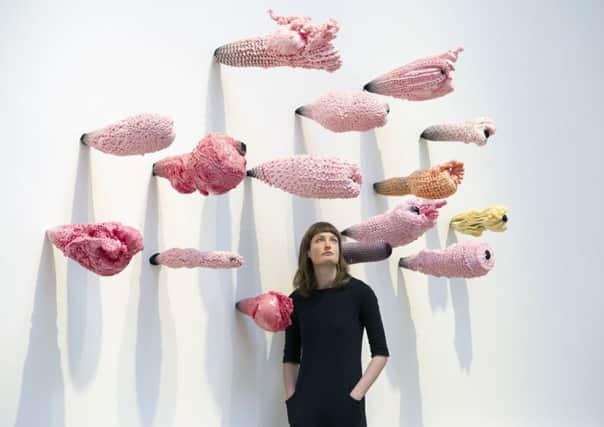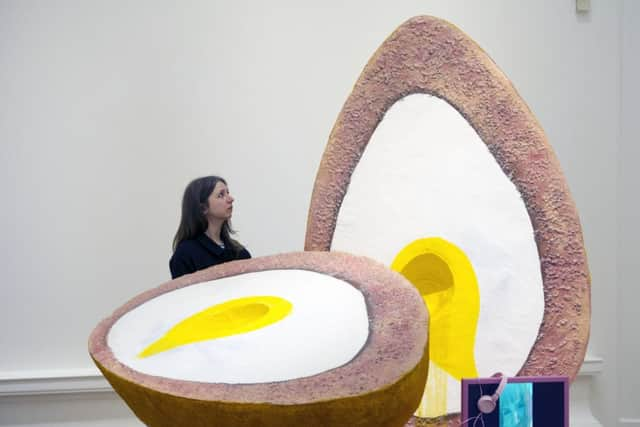Art review: RSA New Contemporaries exhibition


RSA NEW CONTEMP-ORARIES
Royal Scottish Academy, Edinburgh
Star rating: ****


DUNCAN SHANKS SKETCH-BOOKS: THE POETRY OF PLACE
Hunterian Art Gallery and Museum, Glasgow
Star rating: ****
New Contemporaries is the annual harvest of talent from the five Scottish art schools and this has been a good year. This annual exhibition has come a long way from the old student show, too. Then it brought together what the art schools thought were their best graduates of the year. Now it is chosen and curated by members of the RSA. It is a big job going round all the degree shows, but it pays off in the quality of what’s on view. It is not entirely an open beauty contest, however. Politics demand that the individual art schools are represented in proportion to their size. So there are 15 artists each from Edinburgh and Glasgow, 13 from Dundee, six from Aberdeen and two from Moray College. Altogether that makes 51. Compare that to the recent annual society shows where there were three or four hundred in each exhibition and only using the main floor, you get a sense of how these young artists are really given space to show their paces and indeed much of the work is really interesting and full of promise.
In the central position as you enter, Transposition by Emma Smith greets you. It is a pair of red velvet curtains, fringed with gold and drawn back with gold ties. Upside down and opening on nothing, they suggest a big question mark. Even before that, however, Erin Fairley has suspended a web of orange rope above the grand staircase. Photographs show that she has previously taken her net into the hills to hang it up in the landscape as though to capture a little bit of it. No doubt the wind whistled through it on the hillsides and she has also made a set of glazed spherical pots whose purpose seems to be to catch its sound, played back here through earphones. Deb Marshall has used sound as her principle medium, playing music round a classical cast. But Moira Watson threatens us with atomic bombs. She has hung from the ceiling four sinister models of Little Boy and Fat Man, the bombs that fell on Hiroshima and Nagasaki with such terrible results, and has called the work Control, Money, Power.
Advertisement
Hide AdBut much of the best work here is more directly pictorial. Using paper, paint and pastel, sewing, weaving and collage, Dominic McIvor, for instance, has tried to balance the formality of a grid against the minor irregularities which inevitably occur with human execution. The result is an enormous and rather beautiful patchwork quilt. Seamus Killick has taken VHS cassettes and painted on them to create a collection of wild Pop images, in style somewhere between Paolozzi and Steven Campbell. Even wilder though is the work of Caitlin Hynes. She uses textiles mixed in with other media and has created a construction and two large, richly coloured patchwork pictures. One of these called For the Love Poured Over Me is as exuberantly grotesque as the work of James Ensor. Equally striking and equally wild, though more monochromatic, are Samantha Wilson’s big works on paper. She too assembles a company of grotesques, but her people are more melancholy than exuberant. They are mostly drawn in black and white, but their features tend to dissolve into sinister-looking washes of red, yellow and black as though they have been burnt, or worse, afflicted by some monstrous, deforming virus. Charlotte Nash also suggests deformity. She uses extruded foam to make weird shapes like strange, bright pink sea creatures. Fiona Beveridge has also found ways of making weirdly wonderful, semi-animate objects that look like jellyfish or sea anemones by exploiting to great effect the brilliant colours of our plastic world.
You really can’t get much more prosaic than a Scotch egg, but Emma Kelsey’s eponymous Scotch Egg is truly surreal. It is a monstrous Scotch egg cut in two to reveal its yellow centre and, although I am sure I never met a soft boiled Scotch egg, its yolk seems to be oozing slightly. This is such a splendid object on its own, a film presented alongside does seem an unnecessary distraction.
Christel Sorensen’s Melting Diamond is a video projection onto an enormous diamond shape that does indeed seem to have melted to form a puddle. The film does various things, but most compelling is a disembodied eye that stares out lugubriously at us from time to time. Richard Phillips-Kerr also uses video. He projects film of a naked man onto a life-size, naked male figure. His eyes appear to move. He scratches himself. There is even a certain amount of twitching around his private parts, although nothing really untoward happens in that department. The nicest effect is the haloed shadow of the figure on the wall behind. Kirstin Clark has walked 588 times around a board covered with flour and filmed herself doing it. I am not quite sure what her purpose could have been, but the resulting floury board is displayed on the floor as an art work. Sarah Sheard’s Owlboatman shows John Bellany paddling a boat over a blue sea against the Forth Bridge, all in a glass cabinet. It is rather charming, although overall, with a Bellany Box and a Blackadder Bureau, she does seem a bit ambivalent about her host, the RSA, and what it stands for. At one point she has written “Old Contemporaries” under a caricature of Bellany’s painting Totentanz.
I suppose that is fair enough. There must be old contemporaries if there are new ones and Duncan Shanks, showing at the Hunterian, must certainly count as one of the most distinguished of the older generation. The exhbition celebrates the generous gift he has made to the gallery of a hundred sketch books. As an artist dedicated to landscape and in particular to the landscape of the Upper Clyde, he has constantly drawn on the spot, noting a scene momentarily illuminated by a shaft of light, or animated by a flight of birds, a bush with a distinctive shape, and all sorts of things that make up the living landscape. The sketchbooks displayed open in a huge vitrine are beautiful in themselves. With them now housed in a museum, his wonderful command of drawing, almost always in colour and rapidly executed, but also always tellingly coherent, will also be a permanent reminder to the younger generation of how the immense richness of the seen world can be revealed by the hand of a master. For the artist himself, however, his sketches are only a means to an end. He does not simply make a sketch, go back to the studio and work it up into a painting. The work often evolves from the germ of sketch into something far removed. Since he began to find his way as a painter in the Seventies, he has sought to transcend the limitations of landscape seen traditionally as a two dimensional echo of a static, three-dimensional scene because, of course, it never is static. Nor is it actually in three dimensions, but four. Landscape changes as we change in relationship to it, even if only by moving around. We see that inconstancy and so in a sense see time. Constable and Cézanne were both preoccupied by this problem. Shanks, inspired by abstract painting but also by contemporary music, has sought his own solution and has created a kind of painting that really isn’t static at all. It is as restless and turbulent as Corra Linn, one of the great Falls of Clyde near his home, and subject of some of his most dramatic paintings. His is a bold and highly original kind of painting and he deserves much more recognition than he has received hitherto. Perhaps this munificent gift and the show that celebrates it will be a step in that direction.
• RSA New Contemporaries until 8 April; Duncan Shanks Sketchbooks until 16 August; The Poetry of Place, an in-depth analysis of Duncan Shanks’s work, edited by Anne Dulau, is available from Freight Books, www.freightbooks.co.uk
FOLLOW US
SCOTSMAN TABLET AND MOBILE APPS